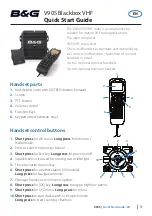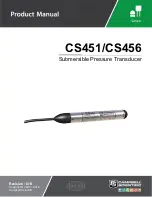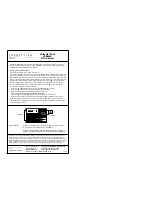
3) Re-assembly is the reverse of assembly with the rear screws installed before the side
screws.
8
THEORY OF OPERATION
8.1
DTX-965 RF BOARD
8.1.1
RECEIVER
RF amplifier and Bandpass Filters
The incoming RF signal from the antenna connector passes backwards through the transmitter
harmonic filter and to a diode switch. The diode switch, CR101, CR201, and CR202 route the RF
signal to a SAW Filter FL101 and then an amplifier Q101. The amplifier is followed by another
SAW Filter. The SAW Filters are designed to pass all signals within the 935-940 MHz band
without much attenuation, but to attenuate out-of-band signals.
1
st
Mixer, 1
st
IF filters, and 1
st
IF Amplifier
The output of the front-end stage is passed to the first mixer U101. This device converts the RF
signal to the first IF frequency of 43.65 MHz. L102, R105, and C107 match the mixer output to the
1
st
IF filter Y101.
The first IF filter, Y101, is at the first IF frequency of 43.65 MHz and has a passband of +/-6 kHz.
This is followed by an identical filter, Y102. The output of the 1
st
IF filters is amplified by Q105
and then routed to the IF IC U102.
2
nd
IF IC
U102 is an integrated FM IF IC which contains a mixer, high gain limiting IF amplifier, FM
discriminator (detector), and other support circuitry. The mixer in U102 converts the RF signal at
the first IF to the second IF of 450 kHz. The output of the mixer exits the IC and is filtered by the
either Narrowband IF filter, FL103, or Very NarrowBand IF Filter, FL104. The output of the filter
re-enters the IC and drives the high gain limiting amplifier. Because the discriminator inside U102
is sensitive to both amplitude and frequency modulation components, a limiter must precede it to
remove any amplitude modulation. The output of the limiter amplifier drives the discriminator.
The resonator for the discriminator is Y103.
2
nd
Local Oscillator
The two mixers in this radio act to produce an output signal whose frequency is equal to the
difference between the frequency present at the RF input port and the frequency at the local
oscillator port. To convert signals at the first IF frequency of 43.65 MHz to that of the second IF
at a frequency of 450 kHz, a local oscillator signal at a frequency of 43.2 MHz (43.65
– 0.45) is
used. This signal is created by tripling the output of the radio’s 14.4 MHz master reference
oscillator, Y401. Transistor Q106 acts as a frequency tripler. Its associated components are
used to bias the transistor at an harmonic rich bias point and to filter the output such that only the
third harmonic remains for use as the 2
nd
local oscillator.
VCO and Synthesizer
The frequency synthesizer is responsible for generating the carrier in transmit and the first local
oscillator in receive. A voltage-controlled oscillator (VCO) is an oscillator whose frequency can
be controlled by an external signal. The receiver synthesizer, almost wholly contained within
U401, divides the VCO frequency by digital dividers and compares the result with an accurate
reference. An error signal, proportional to the frequency error is created which is routed to the
frequency control input of the VCO. This action locks the VCO to a frequency which is equal to
the reference frequency multiplied by the divider number. To set the VCO frequency, different
divider numbers can be programmed into the synthesizer. In most synthesizer designs, the
divider must be an integer, which forces the reference frequency to be equal to the synthesizer
step size. This synthesizer, however, uses a fractional-N technique to generate smaller step
sizes. The reference frequency is derived by digitally dividing the frequency of the 14.4 MHz
master oscillator. When locked, the VCO attains the same relative frequency stability as that of
the master oscillator.







































